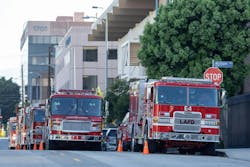Chauffeurs for Los Angeles Fire Chiefs May be Cut Amid Budget Woes
To Los Angeles City Council members searching desperately for cuts amid a budget crisis, the Fire Department's emergency incident technicians are "drivers" whose main role is chauffeuring battalion chiefs to emergencies.
But LAFD officials say the position is much more than that. Emergency incident technicians are firefighters who play a key role in coordinating the response to fires, and losing them would put lives at risk, according to LAFD interim Chief Ronnie Villanueva.
"This is going to come back and bite us. This is not a matter of them just being a driver. It is not a driver. You have to just take that out of your minds of transporting someone somewhere," Villanueva said, addressing the City Council's budget committee at a hearing on Thursday.
Five months after the Palisades fire destroyed thousands of homes and prompted questions about whether the Fire Department was equipped to fight such a massive blaze, the budget committee moved forward with a recommendation to cut the emergency incident technician positions.
Of the 42 positions, 27 are currently filled. Those firefighters would not lose their jobs but would be reassigned, saving the city more than $7 million in the next fiscal year and about $10 million every year after that, according to City Administrative Officer Matt Szabo.
The city is facing a nearly $1-billion budget shortfall largely due to rising personnel costs, soaring legal payouts and a slowdown in the local economy. Mayor Karen Bass' 2025-26 budget proposal, which suggested laying off more than 1,600 city employees, did not include reassigning the emergency incident technicians.
The budget committee, which stressed that the overall Fire Department budget is increasing, also recommended nixing Bass' plan for creating a new unit within the department that would have added 67 employees to address issues stemming from the homelessness crisis.
At Thursday's budget hearing, Councilmember Tim McOsker, who has two children who are firefighters, argued for cutting the emergency incident technician position, calling it "basically an aide."
When Villanueva asked McOsker to put a cost on a firefighter's life, McOsker said, "Invaluable."
"I can say the same thing about very many of the 1,300 positions we're cutting, because we're also going to not be doing sidewalks, streets, curbs, gutters, tree trimming, changing out lights, making our communities safe," McOsker added. "The reality is we have to balance a budget."
The budget committee has sent its initial recommendations to Chief Legislative Analyst Sharon Tso, the City Council's top policy advisor, who on Friday will present the committee with a full menu of strategies for cutting costs while preserving as many services as possible. The committee is then expected to finalize its recommendations and send the proposed budget to the full council, which must approve a final budget by the end of the month.
On the way to a scene, a "command team" consisting of a chief and an emergency incident technician "might be responsible to provide direction to the rescue of a trapped firefighter or civilians, firefighter tracking, and handle the risk management of a rapidly escalating incident," Capt. Erik Scott, an LAFD spokesperson, said in a statement.
"The more complex the incident, the greater the need for Emergency Incident Technicians to facilitate emergency incident mitigation," Scott added, with the types of incidents including "structure fires, brush fires, multi-casualty incidents, earthquakes, train collisions, building collapses, active shooter, airport and port emergencies etc."
Gregg Avery, who retired last year as a battalion chief after 37 years with the LAFD, said that during his career, emergency incident technicians were called aides, then staff assistants. But Avery thought of them more as partners. The four EITs who worked for him often helped him with strategic decisions, and he encouraged them to question his decisions and offer advice.
"The EIT happens to drive the car. But to call them a driver is a bit demeaning and a bit minimizing," he said.
While an EIT drives a battalion chief to a fire or other emergency, both work the radios to develop strategies for tackling the situation, according to Avery and a video produced by the LAFD. They communicate with fire commanders, firefighters on the scene, police officers and agencies such as the Department of Water and Power and the U.S. Forest Service.
At the scene, they work with the incident commander to keep track of firefighters and other personnel — a crucial role in chaotic situations when forgetting a single firefighter's location could be fatal, both Villanueva and Avery said.
But at the Thursday budget hearing, Villanueva struggled to articulate what EITs do when they aren't responding to scenes.
"They visit fire stations and they deliver mail. They talk about the current events. If there's any questions they need to be asked … the EIT will assist with those. They do staffing," Villanueva said.
According to Avery, EITs act as liaisons between firefighters and battalion chiefs. Since they are firefighters themselves and members of the labor union, they can relate to the rank-and-file, Avery said.
The EIT positions were cut once before — in 2010, during another major budget crunch in the Great Recession. Since then, the department has been adding them back.
Avery remembers working without an EIT after the cuts.
"Emergency operations were profoundly different and not as good," he said.
This story originally appeared in Los Angeles Times.
©2025 Los Angeles Times. Visit latimes.com. Distributed by Tribune Content Agency, LLC.
